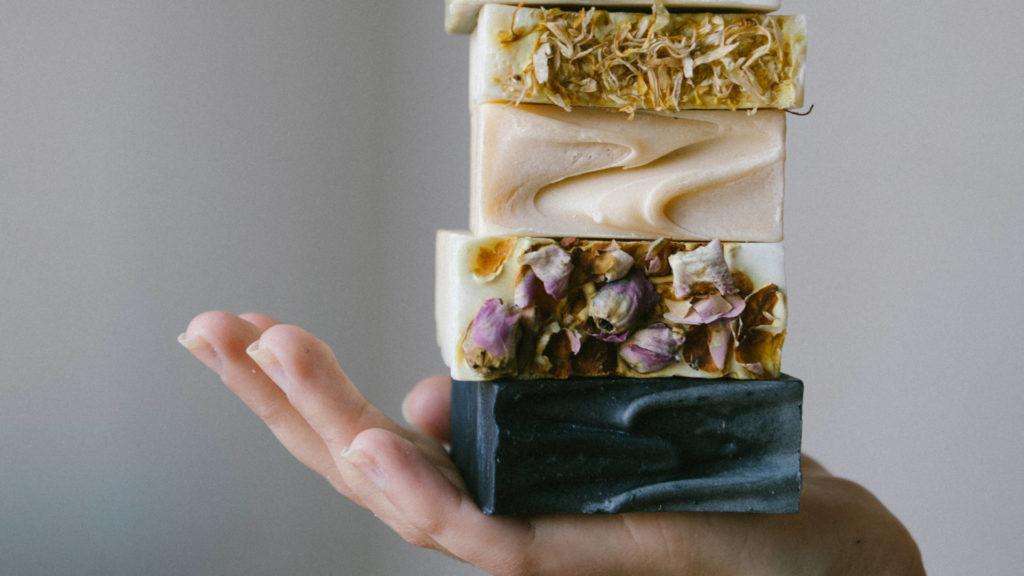FREE REPORT: Make Money Selling Homemade Soap

Here is your free report on how to make money selling homemade soap. Start a side hustle and learn how to scale up to be a full-time business selling spa products.
If you have any questions, feel free to reach out to us or join our Facebook Group to get more tips.
How to Make Basic Soap
Ingredients:
- 1 pound of vegetable shortening or lard
- 6 ounces of water
- 2.2 ounces of lye
- Optional: essential oils or other additives such as oatmeal or dried herbs
Tools:
- Safety equipment: rubber gloves, goggles, long-sleeved shirt, and pants
- A scale to measure ingredients
- A large mixing bowl
- A wooden spoon
- A pot to melt the shortening or lard
- A thermometer
- Soap molds
Instructions:
Put on your safety equipment.
Measure out the water into a heat-resistant container.
Weigh out the lye and slowly add it to the water while stirring. The mixture will heat up quickly and release fumes, so make sure you’re working in a well-ventilated area.
Melt the vegetable shortening or lard in a pot over low heat.
Once both the lye solution and the shortening or lard have cooled down to about 100-110°F, pour the lye solution into the shortening or lard while stirring.
Keep stirring until the mixture reaches “trace,” which is when the mixture thickens to a pudding-like consistency. You can check for trace by dripping a spoonful of the mixture back into the pot and seeing if it leaves a visible trail on the surface.
If you want to add essential oils or other additives, stir them into the mixture at this point.
Pour the mixture into soap molds and let it sit for 24 hours to harden.
Remove the soap from the molds and let it cure for at least four weeks to allow the lye to fully react with the oils, making the soap safe to use.
Enjoy your homemade soap!
Note: Be very careful when working with lye, as it is a caustic substance that can burn skin and eyes. Always wear protective equipment and keep vinegar on hand to neutralize any spills or splashes.
How to Create Scented Soaps
Here are three essential oil recipes for soaps that you can try:
1. Refreshing Citrus Soap:
- 10 drops of lemon essential oil
- 10 drops of sweet orange essential oil
- 5 drops of grapefruit essential oil
2. Calming Lavender Soap:
- 15 drops of lavender essential oil
- 5 drops of cedarwood essential oil
3. Energizing Mint Soap:
- 10 drops of peppermint essential oil
- 10 drops of eucalyptus essential oil
- 5 drops of tea tree essential oil
To make the soap, you can use a soap base of your choice, such as glycerin or shea butter. Melt the soap base according to the package instructions, add your essential oil blend, and pour into soap molds.
Allow the soap to cool and harden, and then remove from the molds. These recipes are just a starting point, so feel free to adjust the amount of essential oil according to your personal preference.
How to Make a Profit Selling Soaps
If you’re interested in selling homemade soaps, here are some steps you can take to make money:
Develop a unique and high-quality product: Research different soap recipes and ingredients to create a unique and high-quality soap that stands out in the market. Experiment with different scents, colors, and textures to create a product that appeals to your target audience.
Brand your soap business: Develop a brand that reflects the values and mission of your business. This includes a catchy name, logo, and packaging that is consistent across all your products.
Price your soap competitively: Research the market and set a price for your soap that is competitive and profitable. Take into account the cost of ingredients, packaging, and any other expenses related to your business.
Market your soap: Use social media, online marketplaces, or local craft fairs to promote your soap to potential customers. Consider offering discounts or free samples to attract customers and build your customer base.
Follow legal requirements: Check with your local authorities to ensure that you’re following all legal requirements for selling soap, such as obtaining proper licenses, registering your business, and labeling your products correctly.
Continuously improve your product and business: Listen to customer feedback, continuously experiment with new ingredients and scents, and adapt your business strategy as needed to ensure that your soap business stays relevant and profitable.
Remember that making money selling homemade soap takes time, effort, and dedication. However, if you’re passionate about creating high-quality products and building a loyal customer base, it can be a rewarding and profitable business venture.
Looking for more homemade soap recipes? The Handcrafter’s Companion has dozens of other ideas for soaps, lotions, bath bombs, balms and more!
Happy creating!
Jane Church
Spa Product Queen
The Handcrafter’s Companion
Join THC Facebook Group
Sign up for the official Handcrafter's Companion Facebook Group to get more spa product tips & ideas.
Join the Community!Get 126+ Spa Product Recipes to make at Home
Get your comprehensive, step-by-step guide to creating your own spa-quality products, for fun and profit!
Need help launching your business?
We have all the tools needed to help you launch a successful spa product business. Pick the option that is right for you.
DIY: Hobby to Business Pro for $7Done For You Business Package